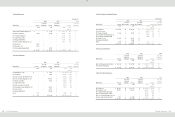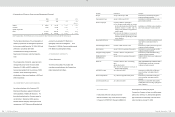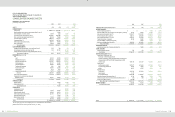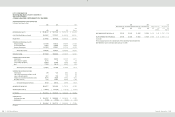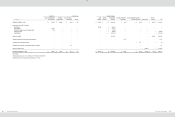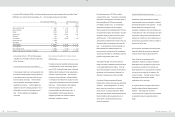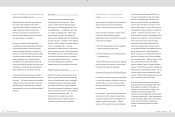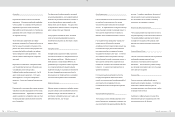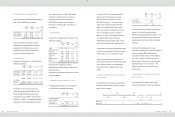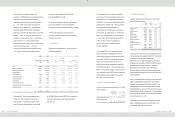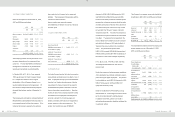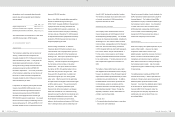HTC 2008 Annual Report Download - page 103
Download and view the complete annual report
Please find page 103 of the 2008 HTC annual report below. You can navigate through the pages in the report by either clicking on the pages listed below, or by using the keyword search tool below to find specific information within the annual report.
Financial Information
| 71
70 |
2008 Annual Report
In January 2007 and October 2008, the Company wholly acquired the shares issued by Communication Global
Certification Inc. and One & Company Design, Inc. The net assets acquired were as follows:
Communication Global Certification Inc.
One & Company Design, Inc.
NT$
NT$
US$
(Note 3)
Cash on hand and in banks
$
39,961
$
7,336
$
224
Other current assets
40,201
12,378
377
Property
175,940
16,620
507
Intangible assets
174,253
115,055
3,508
Other assets
3,913
164
5
Current liabilities
(
63,315
)
(
15,220
)
(
464
)
Long-term bank loans
(
90,050
)
-
-
Other liabilities
(
903
)
-
-
Total consideration
$
280,000
$
136,333
$
4,157
Cash consideration
$
280,000
$
136,333
$
4,157
Cash on hand and in banks
(
39,961
)
(
7,336
)
(
224
)
Expected net cash outflow on the acquisition of a subsidiary
$
240,039
$
128,997
$
3,933
As mentioned in Note 1, HTC and the foregoing
subsidiaries are hereinafter referred to collectively
as the “Company.”
Current/Noncurrent Assets and Liabilities
Current assets include cash, cash equivalents, and
those assets held primarily for trading purposes or
to be realized, sold or consumed within one year
from the balance sheet date. All other assets
such as properties and intangible assets are
classified as noncurrent. Current liabilities are
obligations incurred for trading purposes or to be
settled within one year from the balance sheet
date. All other liabilities are classified as
noncurrent.
Financial Assets/Liabilities at Fair Value through
Profit or Loss
Financial instruments classified as financial assets
or financial liabilities at fair value through profit or
loss (“FVTPL”) include financial assets or financial
liabilities held for trading and those designated as
at FVTPL on initial recognition. The Company
recognizes a financial asset or a financial liability
on its balance sheet when the Company becomes
a party to the contractual provisions of the financial
instrument. A financial asset is derecognized
when the Company has lost control of its
contractual rights over the financial asset. A
financial liability is derecognized when the
obligation specified in the relevant contract is
discharged, cancelled or expired.
Financial instruments at FVTPL are initially
measured at fair value. Transaction costs directly
attributable to the acquisition of financial assets or
financial liabilities at FVTPL are recognized
immediately in profit or loss. At each balance
sheet date subsequent to initial recognition,
financial assets or financial liabilities at FVTPL are
remeasured at fair value, with changes in fair value
recognized directly in profit or loss in the year in
which they arise. Cash dividends received
subsequently (including those received in the year
of investment) are recognized as income for the
year. On derecognition of a financial asset or a
financial liability, the difference between its
carrying amount and the sum of the consideration
received and receivable or consideration paid and
payable is recognized in profit or loss.
A derivative that does not meet the criteria for
hedge accounting is classified as a financial asset
or a financial liability held for trading. If the fair
value of the derivative is positive, the derivative is
recognized as a financial asset; otherwise, the
derivative is recognized as a financial liability.
Fair values of financial assets and financial
liabilities at the balance sheet date are determined
as follows: publicly traded stocks - at closing
prices; open-end mutual funds - at net asset
values; bonds - at prices quoted by the Taiwan
GreTai Securities Market; and financial assets and
financial liabilities without quoted prices in an
active market - at values determined using
valuation techniques.
Available-for-Sale Financial Assets
Available-for-sale financial assets are initially
measured at fair value plus transaction costs that
are directly attributable to the acquisition. At each
balance sheet date subsequent to initial
recognition, available-for-sale financial assets are
remeasured at fair value, with changes in fair value
recognized in equity until the financial assets are
disposed of, at which time, the cumulative gain or
loss previously recognized in equity is included in
profit or loss for the year.
The recognition, derecognition and the fair value
bases of available-for-sale financial assets are
similar to those of financial assets at FVTPL.
Cash dividends are recognized on the
stockholders’ resolutions, except for dividends
distributed from the pre-acquisition profit, which
are treated as a reduction of investment cost.
Stock dividends are not recognized as investment
income but are recorded as an increase in the
number of shares. The total number of shares
subsequent to the increase is used for
recalculation of cost per share.
An impairment loss is recognized when there is
objective evidence that the financial asset is
impaired. Any subsequent decrease in
impairment loss for an equity instrument classified
as available-for-sale is recognized directly in
equity.


